Popular categories
Looking for a yarn?

75% Mohair, 25% Silk
from 6.75 $ /25g
Order DROPS Kid-Silk from Wool Warehouse Direct Ltd

|
DROPS Kid-Silk uni colour 75% Mohair, 25% Silk |
6.75 $ /25g |
Order |
Clicking the ORDER button will redirect you to Wool Warehouse Direct Ltd website
The yarn cost is calculated from the pattern’s smallest size and the yarn’s cheapest product type. Looking for an even better price? You might find it on the DROPS Deals!
Pink Infusion
Knitted sweater in 4 strands DROPS Kid-Silk. The piece is worked top down with diagonal/European shoulders and stripes. Sizes XS - XXL.
DROPS Design: Pattern ks-205
Yarn group A + A + A + A
-------------------------------------------------------
SIZES:
XS - S - M - L - XL - XXL
Finished measurements:
Chest measurements: 102-108-116-126-138-150 cm = 40"-42½"-45¾"-49½"-54¼"-59"
Full length: 56-58-60-62-64-66 cm = 22"-22¾"-23⅝"-24⅜"-25¼"-26"
All measurements in charts are in cm.
MATERIALS:
DROPS Kid-SILK from Garnstudio (belongs to yarn group A)
125-150-175-175-200-225 g color 01, off white
125-150-175-175-200-225 g color 13, pink
50-75-75-75-75-75 g color 03, light pink
NEEDLES:
DROPS CIRCULAR NEEDLE SIZE 7 MM = US 10.75: Length 40 cm = 16" and 80 cm = 32".
DROPS CIRCULAR NEEDLE SIZE 6 MM = US 10: Length 40 cm = 16" and 80 cm = 32".
DROPS DOUBLE POINTED NEEDLES SIZE 7 MM = US 10.75.
DROPS DOUBLE POINTED NEEDLES SIZE 6 MM = US 10.
The technique MAGIC LOOP can be used – you then only need circular needle of 80 cm = 32" in each size.
KNITTING GAUGE:
13 stitches in width and 15 rows in height with stockinette stitch and 4 strands = 10 x 10 cm = 4" x 4".
NOTE: Needle size is only a guide. If you get too many stitches on 10 cm = 4", change to a larger needle size. If you get too few stitches on 10 cm = 4", change to a smaller needle size.
-------------------------------------------------------
Alternative Yarn – See how to change yarns here
Yarn Groups A to F – Use the same pattern and change the yarn here
Yarn usage using an alternative yarn – Use our yarn converter here
-------------------------------------------------------

75% Mohair, 25% Silk
from 6.75 $ /25g
Order DROPS Kid-Silk from Wool Warehouse Direct Ltd

|
DROPS Kid-Silk uni colour 75% Mohair, 25% Silk 6.75 $ /25g Order |
Clicking the ORDER button will redirect you to Wool Warehouse Direct Ltd website
The yarn cost is calculated from the pattern’s smallest size and the yarn’s cheapest product type. Looking for an even better price? You might find it on the DROPS Deals!
- English (US/in)
- Česky
- Dansk
- Deutsch
- Eesti keel
- English (UK/cm)
- Español
- Français
- Íslenska
- Italiano
- Magyar
- Nederlands
- Norsk
- Polski
- Português
- Suomi
- Svenska
- English (UK/cm), Bulgaria
- English (UK/cm), Croatia
- English (UK/cm), Greece
- English (UK/cm), Latvia
- English (UK/cm), Lithuania
- English (UK/cm), Romania
- English (UK/cm), Slovenia
- Česky, Slovakia
Pattern instructions
EXPLANATIONS FOR THE PATTERN:
-------------------------------------------------------
RIDGE/GARTER STITCH (worked back and forth):
Knit all rows.
1 ridge = knit 2 rows.
INCREASE TIP FROM RIGHT SIDE:
Increase AFTER marker:
Use the left needle to pick up the front strand between 2 stitches from the previous round, knit the back loop.
Increase BEFORE marker:
Use the left needle to pick up the back strand between 2 stitches from the previous round, knit the front loop.
INCREASE TIP FROM WRONG SIDE:
Increase AFTER marker:
Use the left needle to pick up the back strand between 2 stitches from the previous round, purl the front loop.
Increase BEFORE marker:
Use the left needle to pick up the front strand between 2 stitches from the previous round, purl the back loop.
DECREASE TIP (for sleeves):
Decrease 1 stitch on either side of the marker-thread as follows: Work until there are 3 stitches left before the marker-thread, knit 2 together, knit 2 (marker-thread sits between these 2 stitches), slip 1 stitch as if to knit, knit 1 and pass the slipped stitch over the knitted stitch.
STRIPES:
2 rows with 1 strand color light pink + 3 strands color pink.
2 rows with 2 strands color light pink + 2 strands color pink.
Work 14-15-16-17-18-19 cm = 5½"-6"-6¼"-6¾"-7"-7½" with 1 strand color off white + 2 strands color light pink + 1 strand color pink.
2 rows with 3 strands color light pink + 1 strand color off white
2 rows with 3 strands color off white + 1 strand color light pink
4 strands with color off white to finished length.
-------------------------------------------------------
START THE PIECE HERE:
-------------------------------------------------------
SWEATER – SHORT OVERVIEW OF THE PIECE:
The top of the back piece is worked back and forth, top down as far as the armholes. Stitches are knitted up along each shoulder, then stitches are cast on for the neck and the front piece is worked back and forth, top down as far as the armholes.
The front and back pieces are joined and the body worked in the round. Stitches are knitted up around the armholes and the sleeves worked in the round with short circular needle/double pointed needles. The neck is worked to finish.
BACK PIECE:
Cast on 26-26-28-30-30-30 stitches with circular needle size 7 MM = US 10.75 and 4 strands color pink.
Purl 1 row from the wrong side.
Insert 1 marker inside 3 stitches on each side. Allow them to follow your work onwards, always inside the outermost 3 stitches.
Work stockinette stitch back and forth.
AT THE SAME TIME increase AFTER the marker at the beginning of the row (seen from the right side) and BEFORE the marker at the end of the row – read INCREASE TIP FROM RIGHT SIDE.
On the next row (wrong side) increase in the same way – read INCREASE TIP FROM WRONG SIDE.
Increase both from the right and wrong side a total of 18-20-22-22-24-28 times. After the last increase there are 62-66-72-74-78-86 stitches.
The piece is now measured from here! REMEMBER THE KNITTING GAUGE!
Continue with stockinette stitch for 12-13-14-14-15-15 cm = 4¾"-5⅛"-5½"-5½"-6"-6" along the armhole. Now start to work STRIPES – read description above until the piece measures 14-15-15-16-17-17 cm = 5½"-6"-6"-6¼"-6¾"-6¾" along the armhole. Put piece aside and work the front piece.
FRONT PIECE:
Start with the left shoulder (when the garment is worn).
Knit up 18-20-22-22-24-28 stitches inside 1 edge stitch along the left shoulder on back piece (i.e. knit up 1 stitch in each row on the top edge of the back piece) with 4 strands color pink. Work stockinette stitch back and forth for 7 cm = 2¾". Now increase at the beginning of each row from the right side after the 3 stitches - remember INCREASE TIP FROM RIGHT SIDE. Increase 1 stitch 4 times = 22-24-26-26-28-32 stitches. Put aside after the last row from the wrong side. Now work the right shoulder as follows
Knit up 18-20-22-22-24-28 stitches inside 1 edge stitch along the right shoulder on the back piece. Work stockinette stitch back and forth for 7 cm = 2¾". Now increase at the end of each row from the right side before the 3 stitches - remember INCREASE TIP FROM RIGHT SIDE. Increase 1 stitch 4 times = 22-24-26-26-28-32 stitches. After the last increase, work the last row from the wrong side.
On the next row from the right side work as follows: Stockinette stitch over the 22-24-26-26-28-32 stitches from the right shoulder, cast on 18-18-20-22-22-22 stitches for the neck at the end of the row and work stockinette stitch over the 22-24-26-26-28-32 stitches from the left shoulder = 62-66-72-74-78-86 stitches. When the piece measures 22-23-24-26-27-29 cm = 8¾"-9"-9½"-10¼"-10⅝"-11⅜", start to work stripes.
Work until the piece measures 24-25-27-28-29-31 cm = 9½"-9¾"-10⅝"-11"-11⅜"-12¼" along the armhole.
Now join the front and back pieces for the body as follows:
BODY:
Work the 62-66-72-74-78-86 stitches from the front piece on the needle, cast on 4-4-4-8-12-12 stitches at the end of the row (side), work stockinette stitch over the 62-66-72-74-78-86 stitches from the back piece, cast on 4-4-4-8-12-12 stitches at the end of the row = 132-140-152-164-180-196 stitches.
Work stockinette stitch in the round and continue stripes until the piece measures 48-50-52-54-56-58 cm = 19"-19¾"-20½"-21¼"-22"-22¾" – measured from the top of the shoulder on the front piece. Knit 1 round and increase 24-24-24-28-32-36 stitches evenly spaced = 156-164-176-192-212-232 stitches. Change to circular needle size 6 MM = US 10. Work rib (knit 2, purl 2) for 8 cm = 3⅛". Bind off with knit.
LEFT SLEEVE:
Use circular needle size 7 MM = US 10.75 and 4 strands color pink, knit up from the right side 32-34-36-38-40-40 stitches from the bottom of the armhole and to the top of the shoulder (along the front piece) and 18-18-18-20-20-22 stitches from the shoulder down to the bottom of the armhole (along the back piece) = 50-52-54-58-60-62 stitches.
Work stockinette stitch back and forth for 2-2-2-3-5-5 cm = ¾"-¾"-¾"-1⅛"-2"-2".
Now join the sleeve using short circular needle/double pointed needles size 7 MM = US 10.75 and continue in the round. Insert 1 marker-thread at the beginning of the round (mid-under sleeve). Allow the thread to follow your work onwards.
Start at the marker thread and work stockinette stitch in the round for 4-4-4-4-5-7 cm = 1½"-1½"-1½"-1½"-2"-2¾". Now decrease 2 stitches under the sleeve – read DECREASE TIP.
Decrease like this every 10-10-10-7-7-6 cm = 4"-4"-4"-2¾"-2¾"-2⅜" a total of 4-4-4-5-5-5 times = 42-44-46-48-50-52 stitches. AT THE SAME TIME, when the sleeve measures 11 cm = 4⅜" work stripes in the same way as on the body.
Continue working until the sleeve measures 40-40-40-39-38-36 cm = 15¾"-15¾"-15¾"-15¼"-15"-14¼". There is 8 cm = 3⅛" left; try the sweater on and work to desired length before the rib. Knit 1 round and increase 6-4-6-4-6-4 stitches evenly spaced = 48-48-52-52-56-56 stitches. Change to double pointed needles size 6 MM = US 10. Work rib (knit 2, purl 2) for 8 cm = 3⅛". Bind off a little loosely. The sleeve measures approx. 48-48-48-47-46-44 cm = 19"-19"-19"-18½"-18"-17¼".
Work the other sleeve in the same way, but first knitting up 18-18-18-20-20-22 stitches from the bottom of the armhole to the shoulder along the back piece, then 32-34-36-38-40-40 stitches from the shoulder and down the front piece. Sew the bottom of the armholes together – see sketch.
NECK:
Start on one shoulder and knit up from the right side, inside 1 edge stitch, 64 to 76 stitches around the neck, using short circular needle size 6 MM = US 10 and 4 strands color pink. Work rib in the round (knit 2, purl 2) for 8 cm = 3⅛". Bind off loosely.
Diagram
All measurements in charts are in cm.

|
= sew bottom of armholes: Sew b to B |

|
= stitches for left front shoulder (d) knitted up along left back shoulder (D), stitches for right front shoulder (e), knitted up along right back shoulder (E) |

|
= knitting-direction |

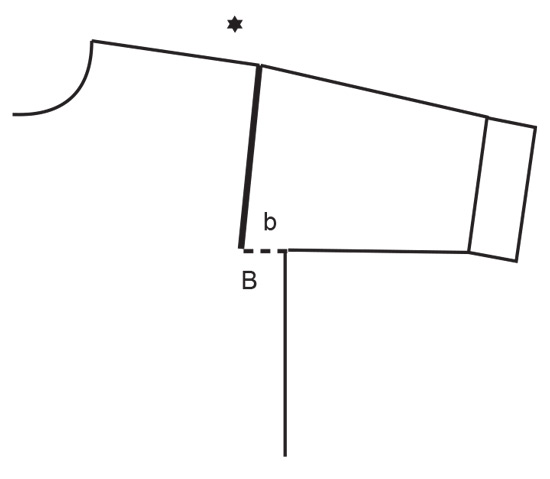

What can you do with our patterns? You can share DROPS patterns online, using the pattern original picture, materials, name and number. But you are NOT ALLOWED to reproduce the complete pattern digitally in any way. Yarn stores are welcome to use the DROPS pattern database to promote the sale of our assortment. You can print out our patterns, make as many copies as you’d like. The only thing we ask is that you don't make any changes / additions to the original printed document. And that the patterns according to the DROPS philosophy are given out to the consumers for free. Editorials that wish to publish our patterns in printed books or magazines can contact us for more information. The sale of garments based on DROPS patterns is permitted as long as they are sold as single items or per order. Further commercial use of the patterns is not permitted. It has to be clearly stated that the garment is made based on a design from DROPS DESIGN. The use of clothing labels of which DROPS DESIGN forms part is conditioned by the inclusion of the following text: “A DROPS DESIGN made by …..”. The use of DROPS photos for marketing purposes/sales is only permitted in connection with the use/sale of DROPS products. The photos may not be cut or edited and the logo should be clearly visible.
We reserve the right to withdraw the permission for use of our patterns at any time, notwithstanding the reason.
Each of our patterns has specific tutorial videos to help you.
These step-by-step tutorials might also help you:
Why is the knitting/crochet tension so important?
Knitting tension is what determines the final measurements of your work, and is usually measured per 10 x 10 cm. It is provided like so: number of stitches in width x number of rows in height - eg: 19 stitches x 26 rows = 10 x 10 cm.
The knitting tension is very individual; some people knit/crochet loosely while others work tightly. You adjust the knitting tension with the needle size, which is why the suggested needle size only serve as a guide! You need to adjust this (up or down) to ensure that YOUR knitting tension matches the knitting tension provided in the pattern. If you work with a different knitting tension than provided you will have a different yarn consumption, and your work will have different measurements than what the pattern suggests.
The knitting tension also determines which yarns can replace each other. As long as you achieve the same knitting tension you can replace one yarn with another.
See DROPS lesson: How to measure your tension/gauge
See DROPS video: How to make a gauge tension swatch
How do I know how many balls of yarn I need?
The required amount of yarn is provided in grams, eg: 450 g. To calculate how many balls you’ll need you first need to know how many grams are in 1 ball (25g, 50g or 100g). This information is available if you click on the individual yarn quality on our pages. Divide the amount required with the amount of each ball. For example, if each ball is 50g (the most common amount), the calculation will be as follows: 450 / 50 = 9 balls.
Can I use a different yarn than what the pattern suggests?
The important thing when changing from one yarn to another is that the knitting/crochet tension remains the same. This is so that the measurements of the finished piece will be the same as on the sketch provided. It is easier to achieve the same knitting tension using yarns from the same yarn group. It is also possible to work with multiple strands of a thinner yarn to achieve the knitting tension of a thicker one. Please try our yarn converter. We recommend you to always work a test swatch.
Please NOTE: when changing yarn the garment might have a different look and feel to the garment in the photo, due to individual properties and qualities of each yarn.
See DROPS lesson: Can I use a different yarn than the one mentioned in the pattern?
What are the yarn groups?
All our yarns are categorised into yarn groups (from A to F) according to thickness and knitting tension – group A contains the thinnest yarns and group F the thickest. This makes it easier for you to find alternative yarns to our patterns, should you wish to switch yarn. All yarns within the same group have a similar knitting tension and can easily replace each other. However, different yarn qualities have different structures and properties which will give the finished work a unique look and feel.
How do I use the yarn converter?
At the top of all our patterns you’ll find a link to our yarn converter, which is a helpful tool should you wish to use a different yarn than suggested. By filling in the yarn quality you wish to replace, the amount (in your size) and number of strands, the converter will present good alternative yarns with the same knitting tension. Additionally it will tell you how much you’ll require in the new qualities and whether you’ll need to work with multiple strands. Most skeins are 50g (some are 25g or 100g).
If the pattern is worked with multiple colours, every colour will have to be converted separately. Similarly, if the pattern is worked with several strands of different yarns (for example 1 strand Alpaca and 1 strand Kid-Silk) you will have to find alternatives for each, individually.
Why do you show discontinued yarns in the patterns?
Since different yarns have different qualities and textures we have chosen to keep the original yarn in our patterns. However, you can easily find options among our available qualities by using our yarn converter, or simply pick a yarn from the same yarn group.
It is possible that some retailers still have discontinued yarns in stock, or that someone has a few skeins at home that they would like to find patterns for.
The yarn converter will provide both alternative yarn as well as required amount in the new quality.
What size should I knit?
If you think it's hard to decide what size to make, it can be a good idea to measure a garment you own already and like the size of. Then you can pick the size by comparing those measures with the ones available in the pattern's size chart.
You'll find the size chart at the bottom of the pattern.
See DROPS lesson: How to read size chart
Why do I get the wrong knitting tension with the suggested needle size?
The needle size provided in the pattern serves only as a guide, the important thing is to follow the knitting tension. And since knitting tension is very individual, you will have to adjust the needle size to ensure that YOUR tension is the same as in the pattern – maybe you’ll have to adjust 1, or even 2 needle sizes, up or down to achieve the correct tension. For this, we recommend that you work test swatches.
Should you work with a different knitting tension than the one provided, the measurements of the finished garment might deviate from the measurement sketch.
See DROPS lesson: How to measure your tension/gauge
See DROPS video: How to make a gauge tension swatch
Why is the pattern worked top-down?
Working a garment top-down provides more flexibility and room for personal adjustment. For example it is easier to try the garment on while working, as well as making adjustments to length of yoke and shoulder caps.
The instructions are carefully explaining every step, in the correct order. Diagrams are adjusted to the knitting direction and are worked as usual.
How do I work according to a knitting diagram?
The diagram depicts all rows/rounds, and every stitch seen from the right side. It is read from bottom to top, from right to left. 1 square = 1 stitch.
When working back and forth, every other row is worked from the right side and every other row is worked from the wrong side. When working from the wrong side, the diagram will have to be worked reversed: from left to right, knit stitches are purled, purl stitches are knit etc.
When working in the round every round is worked from the right side and the diagram are worked from right to left on all rounds.
See DROPS lesson: How to read knitting diagrams
How do I work according to a crochet diagram?
The diagram depicts all rows/rounds, and every stitch seen from the right side. It is worked from bottom to top, from right to left.
When working back and forth every other row is worked from the right side: from right to left and every other row is worked from the wrong side: from left to right.
When working in the round, every row in the diagram are worked from the right side, from right to left.
When working a circular diagram you start in the middle and work your way outwards, counter clockwise, row by row.
The rows usually start with a given number of chain stitches (equivalent to the height of the following stitch), this will either be depicted in the diagram or explained in the pattern.
See DROPS lesson: How to read crochet diagrams
How do I work several diagrams simultaneously on the same row/round?
Instructions for working several diagrams after each other on the same row/round, will often be written like so: “work A.1, A.2, A.3 a total of 0-0-2-3-4 times". This means you work A.1 once, then A.2 is worked once, and A.3 is repeated (in width) the number of times provided for your size – in this case like so: S = 0 times, M = 0 times, L=2 times, XL= 3 times and XXL = 4 times.
The diagrams are worked as usual: begin with the first row in A.1, then work the first row in A.2 etc.
See DROPS lesson: How to read knitting diagrams
See DROPS lesson: How to read crochet diagrams
Why are the sleeves shorter in larger sizes?
The total width of the garment (from wrist-to-wrist) will be larger in the larger sizes, despite the actual sleeves being shorter. The larger sizes have longer sleeve caps and wider shoulders, so there will be a good fit in all sizes.
Where on the garment is the length measured?
The measurement sketch/schematic drawing provides information regarding the full length of the garment. If it’s a jumper or a jacket the length is measured from the highest point on the shoulder (usually closest to the neckline), and straight down to the bottom of the garment. It is NOT measured from the tip of shoulder. Similarly, the length of yoke is measured from the highest point on the shoulder and down to where yoke is split into body and sleeves.
See DROPS lesson: How to read a schematic drawing
What is a repeat?
Diagrams are often repeated on the round or in height. 1 repeat is the diagram the way it appears in the pattern. If it says to work 5 repeats of A.1 in the round, then you work A.1 a total of 5 times after/next to each other in the round. If it says to work 2 repeats of A.1 vertically/in height you work the entire diagram once, then begin again at the start and work the entire diagram one more time.
Why does the piece start with more chain stitches than it’s worked with?
Chain stitches are slightly narrower than other stitches and to avoid working the cast-on edge too tight, we simply chain more stitches to begin with. The stitch count will be adjusted on the following row to fit the pattern and measurement sketch.
Why increase before the rib edge when the piece is worked top-down?
The rib edge is more elastic and will contract slightly compared to, for example, stocking stitch. By increasing before the rib edge, you avoid a visible difference in width between the rib edge and the rest of the body.
Why increase in the cast-off edge?
It’s very easy to cast off too tightly, and by making yarn overs while casting off (and simultaneously casting these off) you avoid a too tight cast off edge.
See DROPS video: How to bind off with yarn overs (yo)
How do I increase/decrease on every 3rd and 4th row/round alternately?
To achieve an even increase (or decrease) you can increase on, for example: every 3rd and 4th row alternately, like so: work 2 rows and increase on the 3rd row, work 3 rows and increase on the 4th. Repeat this until the increase is complete.
See DROPS lesson: Increase or decrease 1 st on every 3rd and 4th row alternately
How can I work a jacket in the round instead of back and forth?
Should you prefer to work in the round instead of back and forth, you may of course adjust the pattern. You’ll need to add steeks mid-front (usually 5 stitches), and follow the instructions. When you would normally turn and work from the wrong side, simply work across the steek and continue in the round. At the end you’ll cut the piece open, pick up stitches to work bands, and cover the cut edges.
See DROPS video: How to knit steeks and cut open
Can I work a jumper back and forth instead of in the round?
Should you prefer to work back and forth instead of in the round, you may of course adjust the pattern so you work the pieces separately and then assemble them at the end. Divide the stitches for the body in 2, add 1 edge stitch in each side (for sewing) and work the front and back pieces separately.
See DROPS lesson: Can I adapt a pattern for circular needles into straight needles?
Why is the pattern slightly different than what I see in the photo?
Pattern repeats can vary slightly in the different sizes, in order to get the correct proportions. If you’re not working the exact same size as the garment in the photo, yours might deviate slightly. This has been carefully developed and adjusted so that the complete impression of the garment is the same in all sizes.
Make sure to follow instructions and diagrams for your size!
How do I make a women’s size garment into a men’s size one?
If you have found a pattern you like which is available in women’s size it’s not very difficult to convert it to men’s size. The biggest difference will be the length of sleeves and body. Start working on the women size that you think would fit across the chest. The additional length will be worked right before you cast off for the armhole/sleeve cap. If the pattern is worked top-down you can add the length right after the armhole or before the first decrease on sleeve.
Regarding additional yarn amount, this will depend on how much length you add, but it is better with a skein too many than too few.
How do I prevent a hairy garment from shedding?
All yarns will have excess fibres (from production) that might come off as lint or shedding. Brushed yarns (ie hairier yarns) have more of these loose, excess fibres, causing more shedding.
Shedding also depends on what is worn under or over the garment, and whether this pulls at the yarn fibres. It’s therefore not possible to guarantee that there will be no shedding
Below are some tips on how to get the best result when working with hairier yarns:
1. When the garment is finished (before you wash it) shake it vigorously so the looser hairs come off. NOTE: do NOT use a lint roller, brush or any method that pulls at the yarn.
2. Place the garment in a plastic bag and put it in your freezer - the temperature will cause the fibres to become less attached to each other, and excess fibres will come off easier.
3. Leave in the freezer for a few hours before taking it out and shaking it again.
4. Wash the garment according to the instructions on the yarn label.
Why does my garment pill?
Pilling is a natural process that happens to even the most exclusive of fibers. It's a natural sign of wear and tear that is hard to avoid, and that is most visible in high friction areas of your garment like a sweater's arms and cuffs.
You can make your garment look as new by removing the pilling, using a fabric comb or a pill/lint remover.
In the meantime, you can read the questions and answers that others have left to this pattern or join the DROPS Workshop on Facebook to get help from fellow knitters/crocheters!
You might also like...
Pink Infusion |
||||||||||
 |
 |
|||||||||
Knitted sweater in 4 strands DROPS Kid-Silk. The piece is worked top down with diagonal/European shoulders and stripes. Sizes XS - XXL.
DROPS 240-1 |
||||||||||
|
------------------------------------------------------- EXPLANATIONS FOR THE PATTERN: ------------------------------------------------------- RIDGE/GARTER STITCH (worked back and forth): Knit all rows. 1 ridge = knit 2 rows. INCREASE TIP FROM RIGHT SIDE: Increase AFTER marker: Use the left needle to pick up the front strand between 2 stitches from the previous round, knit the back loop. Increase BEFORE marker: Use the left needle to pick up the back strand between 2 stitches from the previous round, knit the front loop. INCREASE TIP FROM WRONG SIDE: Increase AFTER marker: Use the left needle to pick up the back strand between 2 stitches from the previous round, purl the front loop. Increase BEFORE marker: Use the left needle to pick up the front strand between 2 stitches from the previous round, purl the back loop. DECREASE TIP (for sleeves): Decrease 1 stitch on either side of the marker-thread as follows: Work until there are 3 stitches left before the marker-thread, knit 2 together, knit 2 (marker-thread sits between these 2 stitches), slip 1 stitch as if to knit, knit 1 and pass the slipped stitch over the knitted stitch. STRIPES: 2 rows with 1 strand color light pink + 3 strands color pink. 2 rows with 2 strands color light pink + 2 strands color pink. Work 14-15-16-17-18-19 cm = 5½"-6"-6¼"-6¾"-7"-7½" with 1 strand color off white + 2 strands color light pink + 1 strand color pink. 2 rows with 3 strands color light pink + 1 strand color off white 2 rows with 3 strands color off white + 1 strand color light pink 4 strands with color off white to finished length. ------------------------------------------------------- START THE PIECE HERE: ------------------------------------------------------- SWEATER – SHORT OVERVIEW OF THE PIECE: The top of the back piece is worked back and forth, top down as far as the armholes. Stitches are knitted up along each shoulder, then stitches are cast on for the neck and the front piece is worked back and forth, top down as far as the armholes. The front and back pieces are joined and the body worked in the round. Stitches are knitted up around the armholes and the sleeves worked in the round with short circular needle/double pointed needles. The neck is worked to finish. BACK PIECE: Cast on 26-26-28-30-30-30 stitches with circular needle size 7 MM = US 10.75 and 4 strands color pink. Purl 1 row from the wrong side. Insert 1 marker inside 3 stitches on each side. Allow them to follow your work onwards, always inside the outermost 3 stitches. Work stockinette stitch back and forth. AT THE SAME TIME increase AFTER the marker at the beginning of the row (seen from the right side) and BEFORE the marker at the end of the row – read INCREASE TIP FROM RIGHT SIDE. On the next row (wrong side) increase in the same way – read INCREASE TIP FROM WRONG SIDE. Increase both from the right and wrong side a total of 18-20-22-22-24-28 times. After the last increase there are 62-66-72-74-78-86 stitches. The piece is now measured from here! REMEMBER THE KNITTING GAUGE! Continue with stockinette stitch for 12-13-14-14-15-15 cm = 4¾"-5⅛"-5½"-5½"-6"-6" along the armhole. Now start to work STRIPES – read description above until the piece measures 14-15-15-16-17-17 cm = 5½"-6"-6"-6¼"-6¾"-6¾" along the armhole. Put piece aside and work the front piece. FRONT PIECE: Start with the left shoulder (when the garment is worn). Knit up 18-20-22-22-24-28 stitches inside 1 edge stitch along the left shoulder on back piece (i.e. knit up 1 stitch in each row on the top edge of the back piece) with 4 strands color pink. Work stockinette stitch back and forth for 7 cm = 2¾". Now increase at the beginning of each row from the right side after the 3 stitches - remember INCREASE TIP FROM RIGHT SIDE. Increase 1 stitch 4 times = 22-24-26-26-28-32 stitches. Put aside after the last row from the wrong side. Now work the right shoulder as follows Knit up 18-20-22-22-24-28 stitches inside 1 edge stitch along the right shoulder on the back piece. Work stockinette stitch back and forth for 7 cm = 2¾". Now increase at the end of each row from the right side before the 3 stitches - remember INCREASE TIP FROM RIGHT SIDE. Increase 1 stitch 4 times = 22-24-26-26-28-32 stitches. After the last increase, work the last row from the wrong side. On the next row from the right side work as follows: Stockinette stitch over the 22-24-26-26-28-32 stitches from the right shoulder, cast on 18-18-20-22-22-22 stitches for the neck at the end of the row and work stockinette stitch over the 22-24-26-26-28-32 stitches from the left shoulder = 62-66-72-74-78-86 stitches. When the piece measures 22-23-24-26-27-29 cm = 8¾"-9"-9½"-10¼"-10⅝"-11⅜", start to work stripes. Work until the piece measures 24-25-27-28-29-31 cm = 9½"-9¾"-10⅝"-11"-11⅜"-12¼" along the armhole. Now join the front and back pieces for the body as follows: BODY: Work the 62-66-72-74-78-86 stitches from the front piece on the needle, cast on 4-4-4-8-12-12 stitches at the end of the row (side), work stockinette stitch over the 62-66-72-74-78-86 stitches from the back piece, cast on 4-4-4-8-12-12 stitches at the end of the row = 132-140-152-164-180-196 stitches. Work stockinette stitch in the round and continue stripes until the piece measures 48-50-52-54-56-58 cm = 19"-19¾"-20½"-21¼"-22"-22¾" – measured from the top of the shoulder on the front piece. Knit 1 round and increase 24-24-24-28-32-36 stitches evenly spaced = 156-164-176-192-212-232 stitches. Change to circular needle size 6 MM = US 10. Work rib (knit 2, purl 2) for 8 cm = 3⅛". Bind off with knit. LEFT SLEEVE: Use circular needle size 7 MM = US 10.75 and 4 strands color pink, knit up from the right side 32-34-36-38-40-40 stitches from the bottom of the armhole and to the top of the shoulder (along the front piece) and 18-18-18-20-20-22 stitches from the shoulder down to the bottom of the armhole (along the back piece) = 50-52-54-58-60-62 stitches. Work stockinette stitch back and forth for 2-2-2-3-5-5 cm = ¾"-¾"-¾"-1⅛"-2"-2". Now join the sleeve using short circular needle/double pointed needles size 7 MM = US 10.75 and continue in the round. Insert 1 marker-thread at the beginning of the round (mid-under sleeve). Allow the thread to follow your work onwards. Start at the marker thread and work stockinette stitch in the round for 4-4-4-4-5-7 cm = 1½"-1½"-1½"-1½"-2"-2¾". Now decrease 2 stitches under the sleeve – read DECREASE TIP. Decrease like this every 10-10-10-7-7-6 cm = 4"-4"-4"-2¾"-2¾"-2⅜" a total of 4-4-4-5-5-5 times = 42-44-46-48-50-52 stitches. AT THE SAME TIME, when the sleeve measures 11 cm = 4⅜" work stripes in the same way as on the body. Continue working until the sleeve measures 40-40-40-39-38-36 cm = 15¾"-15¾"-15¾"-15¼"-15"-14¼". There is 8 cm = 3⅛" left; try the sweater on and work to desired length before the rib. Knit 1 round and increase 6-4-6-4-6-4 stitches evenly spaced = 48-48-52-52-56-56 stitches. Change to double pointed needles size 6 MM = US 10. Work rib (knit 2, purl 2) for 8 cm = 3⅛". Bind off a little loosely. The sleeve measures approx. 48-48-48-47-46-44 cm = 19"-19"-19"-18½"-18"-17¼". Work the other sleeve in the same way, but first knitting up 18-18-18-20-20-22 stitches from the bottom of the armhole to the shoulder along the back piece, then 32-34-36-38-40-40 stitches from the shoulder and down the front piece. Sew the bottom of the armholes together – see sketch. NECK: Start on one shoulder and knit up from the right side, inside 1 edge stitch, 64 to 76 stitches around the neck, using short circular needle size 6 MM = US 10 and 4 strands color pink. Work rib in the round (knit 2, purl 2) for 8 cm = 3⅛". Bind off loosely. |
||||||||||
Diagram explanations |
||||||||||
|
||||||||||

|
||||||||||

|
||||||||||

|
||||||||||
|
Have you made this or any other of our designs? Tag your pictures in social media with #dropsdesign so we can see them! Do you need help with this pattern?You'll find tutorial videos, a Comments/Questions area and more by visiting the pattern on garnstudio.com. © 1982-2024 DROPS Design A/S. We reserve all rights. This document, including all its sub-sections, has copyrights. Read more about what you can do with our patterns at the bottom of each pattern on our site. |
||||||||||
With over 40 years in knitting and crochet design, DROPS Design offers one of the most extensive collections of free patterns on the internet - translated to 17 languages. As of today we count 304 catalogs and 11422 patterns - 11417 of which are translated into English (US/in).
We work hard to bring you the best knitting and crochet have to offer, inspiration and advice as well as great quality yarns at incredible prices! Would you like to use our patterns for other than personal use? You can read what you are allowed to do in the Copyright text at the bottom of all our patterns. Happy crafting!








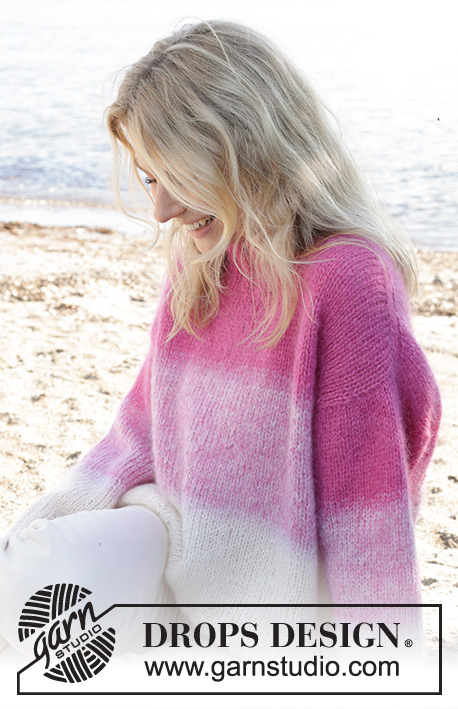



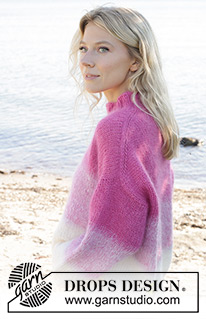
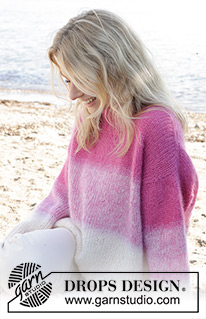



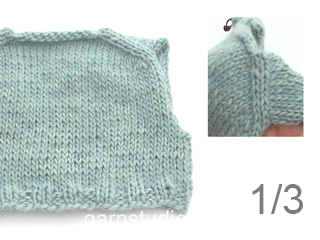
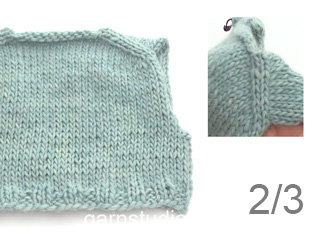
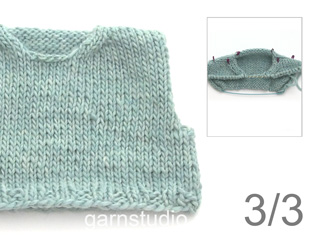



























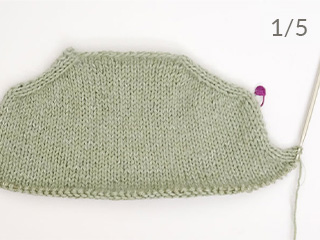
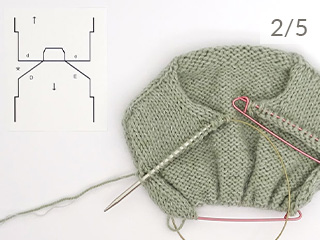
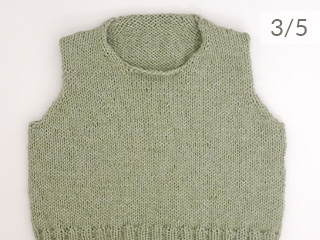

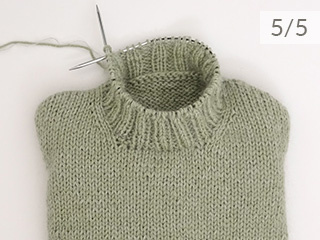
























Comments / Questions (53)
Danke liebes Drops Design für die superschnelle Antwort. Hat mir sehr geholfen. Liebe Grüße Ute Hof
20.03.2024 - 16:11Hallo ihr Lieben, stricke Pink Infusion, Drops 240-1, einfarbig , Größe xl. Warum hat der Armausschnitt des Rückenteils eine Länge von 17 cm und der Armausschnitt des Vorderteils eine Länge von 29 cm (einfarbig). Bin etwas verunsichert. Habe ich einen Denkfehler? Würde mich über euere schnelle Hilfe Freuen. Liebe Grüße Ute Hof der Armausschnitt Rückenteil 17 cm Länge und das Vorderteil ein Armausschnitt
20.03.2024 - 13:47DROPS Design answered:
Liebe Frau Hof, bei solchen Modellen mit europäischen Schultern wird man so stricken, daß der Armausschnitt beim Rückenteil kürzer ist, so sind die Schulter etwas schräg hinten - siehe Tab Videos (oben am Kopfteil) für das Rückenteil und Vorderteil. In XXL ist der Armausschnitt 17 cm beim Rückenteil + 29 cm beim Vorderteil = (46/2)=23 cm hoch, siehe Maßskizze. Viel Spaß beim Stricken!
20.03.2024 - 15:23Bonjour, je voudrais être sûre d'avoir bien compris : (taille M) le dos fait 15cm de haut lorsqu'on le met en attente, mais le devant fait 25cm lorsqu'on rejoint le dos ? On a donc bien 10cm de plus... Merci pour votre réponse
18.03.2024 - 16:27DROPS Design answered:
Bonjour Mme Dolfin, tout à fait, vous avez ainsi bien (15+25)/2=20 cm de hauteur d'emmanchure, dans ce type de modèle, les épaules sont légèrement inclinées dans le dos. Retrouvez sous l'onglet "Vidéos" comment tricoter le dos et les devants de ce type de modèles. Bon tricot!
19.03.2024 - 10:59Bonjour, Je ne comprends pas, j'ai fait mes 20 augmentations sur l'endroit et sur l'envers et j'obtiens 106m pour 25cm le long de l'emmanchure. Il est dit : "augmenter 20 fois au total à la fois sur l'endroit et sur l'envers" J'ai donc fait 20 x 4 mailles (puisque 2 sur l'endroit et 2 sur l'envers). Cela signifie-t-il que j'aurais du faire que 10 x les 4 mailles ? Ce qui donnerait le bon nombre de mailles, mais alors pourquoi dire d'augmenter 20 fois ? Merci
18.03.2024 - 12:14DROPS Design answered:
Bonjour Mme Dolfin, on augmente pour les épaules du dos 20 fois au total, ces augmentations sont faites aussi bien sur l'endroit que sur l'envers, autrement dit, vous tricotez 20 rangs et avec ainsi 26 + (2x20= 66 mailles. Bon tricot!
18.03.2024 - 15:16Hallo, ist das besser, wenn man die Ärmel mit verkürzten Reihen stricken? Danke im Voraus. VG, Linh
20.02.2024 - 11:47DROPS Design answered:
Liebe Linh, die verkürzten Reihen geben eine bessere Form für das Ermetopp, so können Sie einige stricken, oder genauso wie bei diesem Modell stricken. Viel Spaß beim stricken!
20.02.2024 - 15:42Not sure about the height of the stripes at the bottom of the bodice (before the front and back are placed on the circular needle). It would appear that for size M, on the back of the pullover the stripe will be 1 cm high, and on the front 4cm. Is this correct?
04.02.2024 - 11:35DROPS Design answered:
Dear Michele, the position of the stripes is approximate, it may vary depending on the knitting gauge. In the instructions it specifies how many rows or cm you need to work with each colour but it may vary from the one in the photo due to each person's individual gauge. The photo is only a visual guide for the overall result; you should follow the written instructions first in regards to rows and cm to be worked. Happy knitting!
05.02.2024 - 00:01Love the sweater. Will have to figure out how to knit this left handed. The instructions look petty good. Wish I could click a translate button lol.
18.07.2023 - 00:29It would be really helpful if the model height and what general clothes size they are, and also what size the garment is they are modelling.
21.06.2023 - 11:18Dzień dobry. Nigdzie nie mogę znaleźć takiej informacji. Czy mam prawo zrobić sweter z darmowego wzoru i potem go sprzedać(sweter nie wzór)? Jeśli tak to są jakie specjalne warunki? Dziękuję za odpowiedź. Aurelia Gabrysiak
08.03.2023 - 22:55DROPS Design answered:
Witaj Aurelio, sprzedaż gotowej odzieży wykonanej na bazie wzorów DROPS jest dozwolona, o ile są one wytwarzane jednostkowo lub na zlecenie. Po więcej informacji patrz Copyright, który znajduje się na końcu każdego wzoru. Pozdrawiamy!
09.03.2023 - 08:21Kan man strikke denne opskrift i Brushed Alpaka Silk istedet for Kid Silk? Hvor mange tråde?
28.02.2023 - 07:58DROPS Design answered:
Hej Melissa, ja det kan du og da skal du strikke med 2 tråde DROPS Brushed Alpaca Silk. Prøv vores garn-omregner - vælg DROPS Kid-Silk, vælg antal gram i din størrelse og vælg 4 tråde, så får du resultatet i Brushed :)
28.02.2023 - 14:37